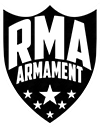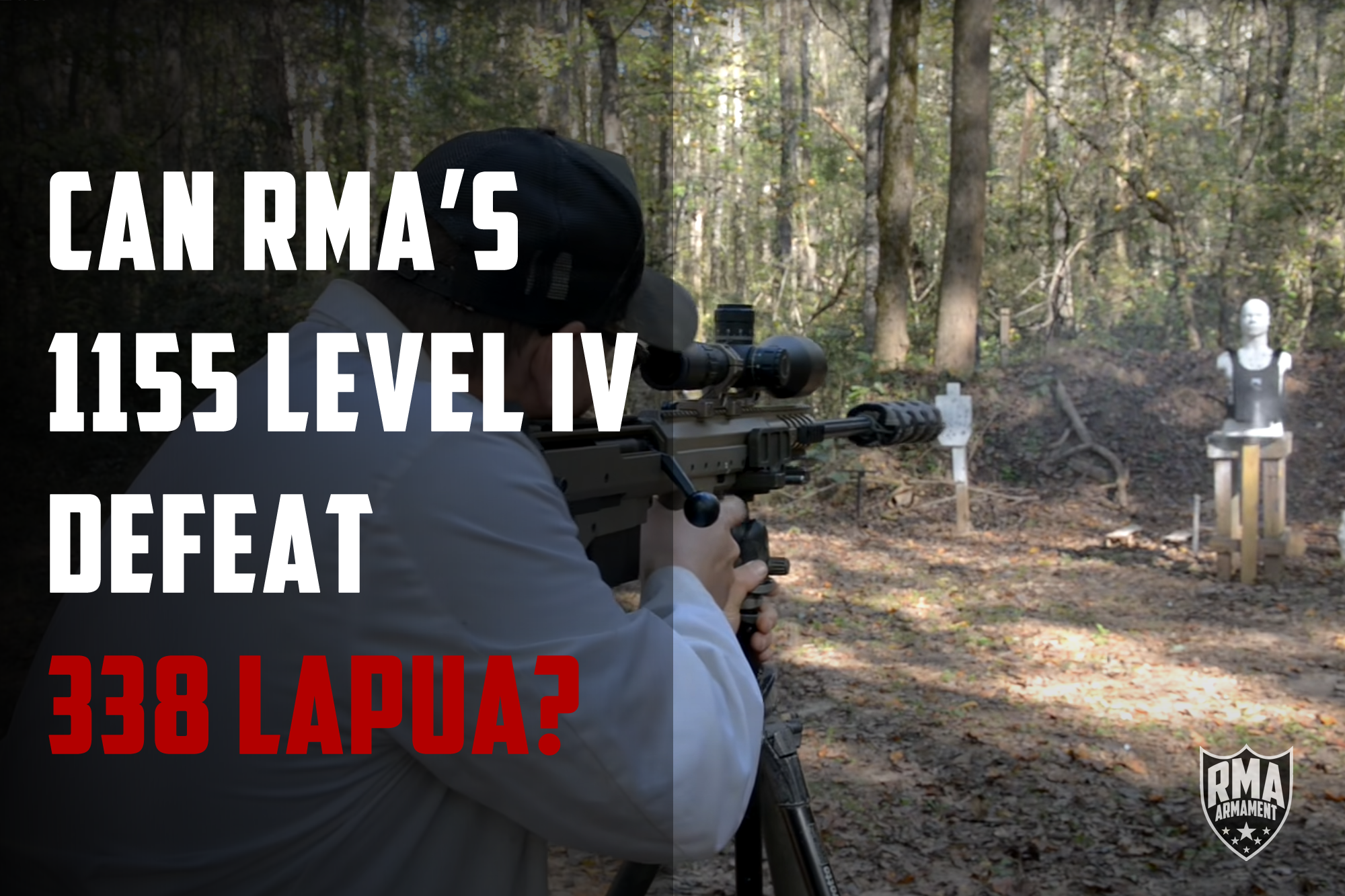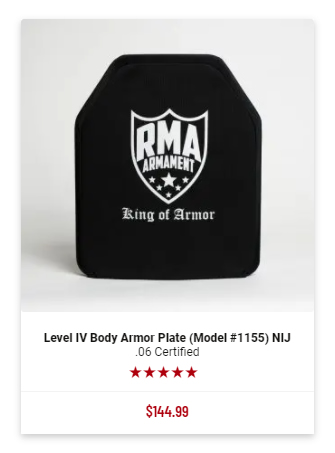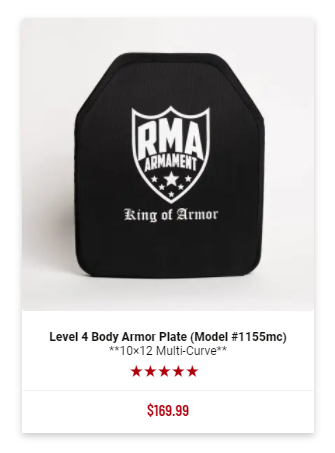Will body armor stop .338 Lapua?
Recently, we shared a video of IraqVeteran8888 testing our Level IV 1155 plates against 338 Lapua.
Here at RMA, we often talk about how our armor is overbuilt against NIJ standards (even Level IV!) to ensure the best protection for our customers. Unlike many others, we don’t ride the absolute razor’s edge on weight and thickness. If you build a plate to the absolute minimum material content necessary to achieve NIJ certification, you’re not building a reliable product. Many of those styles of plates aren’t even certified for exactly that reason. We care about ballistic efficacy and your ability to stay in the fight before flexing marketing buzzwords. The video went viral and the comment section was a little overblown and ridiculous, so we’re going to clean things up right now.
Why .338 Lapua?
While there are plenty of test videos demonstrating how strong our plates are against common threats like 5.56, .308, and others, IraqVeteran8888 wanted to push our most affordable level IV 1155 rifle plates to the absolute limit and see just how good they really are. Aren’t you just a little bit curious, too?
Enter the .338 Lapua. This fast, heavy rifle round often sports metrics like 250 grain projectiles traveling at 2700-2800 FPS or more. To put that in perspective, rounds like .308, 30-06, or 7.62X54r are usually only able to achieve 2700-2800 FPS velocities at much lighter projectile weights in the range of 150-170 grains while staying near SAAMI specs. The .338 Lapua carries a substantially higher energy at impact than the rounds that NIJ tests against, like 30-06 and 308.
Did it work?
Sort of. We certainly didn’t build our 1155 plate to defeat .338 Lapua since that’s pointless for a lot of reasons we’ll discuss. While the round was technically ‘stopped’, the back face deformation was suspect. Why? The material weight required to stop .338 Lapua and keep back face deformation to 44mm or less would ensure that any plate designed to defeat .338 to NIJ standards of lower-powered .308 or 30-06 would never be able to sell to the consumer market. The reality of the armor market is that consumers prioritize price, weight, and thickness. While these are important numbers, there is no magical material that stops 50 BMG, weighs less than a pound, and costs 25 dollars at retail. Given the tradeoffs involved, we’re ecstatic that our products go far beyond their official rating, which is exactly what we design them to do.
Why Doesn’t Anyone Make Armor Designed to Defeat .338 Lapua?
Because body armor is always a system of tradeoffs, it doesn’t really make sense to build a plate to a specification designed to defeat .338 Lapua for the same reason that you can’t buy Level IV AR500 steel body armor or body armor that will safely defeat .50 BMG. (Yes, technically Level IV AR500 plates exist–but they have a ceramic backer since pure Level IV steel is too heavy to wear, so it serves absolutely no purpose whatsoever.) (Yes, technically even our armor has ‘stopped’ .50 BMG at relatively close range. You should never count on any body armor to save you from a round that blows up engines.)
Tactical Considerations
Tactically, it’s difficult to imagine a situation where an attacker would be using .338 Lapua and body armor that is capable of defeating such a round would even make any difference to your survival. The Lapua design lends itself to great accuracy and energy transfer over long distances, which means it largely finds its place in long-range outdoor rural situations. Because it’s such a powerful round, it doesn’t make a lot of sense to deploy it in an urban environment where the shooter runs the risk of overpenetration and collateral damage unless you’re shooting from skyscrapers in a video game where there are no consequences for your actions.
The range of alternative cartridges available for such a job with similarly flat, accurate, and effective ballistics over a shorter range like .308 that come in at a lower price for weapons and ammunition and a lower total system weight with semi-auto options means something like .338 stays in longer-range missions.
It seems unlikely that a sniper with the skillset, equipment, financial backing, and determination to drill you center mass with .338 Lapua would only show up to the fight with a single round and give up immediately afterward. Given that you’re very likely in a wide open area such as a field or across a mountain valley, you really don’t have anywhere to escape to that will ensure your survival at all against this kind of attack. It’s also likely that since you would obviously be wearing body armor, any sniper with the degree of skill necessary to execute such a mission would choose a head or groin shot instead of risking a defeat by your armor at all.
The weight of the materials with current technology required to effectively defeat .338 Lapua with back face deformation of 44mm or less would make such a plate substantially heavier than existing plates, making your speedy escape from such a situation that much more difficult.
The idea of creating a plate designed to be worn on the body to defeat a wildly powerful sniper rifle round doesn’t make a lot of sense to begin with given current battlefield dynamics, technology, and economics.
Materials
Materials that would be suitable for defeating .338 to established back face deformation standards while also being lightweight enough to be practical for wear would price the product out of the market. While we would love to offer the most cutting-edge laboratory technology in all of our products, neither consumers nor the government are willing to purchase armor products that cost an arm and a leg. Even in 2022, we just don’t have the economies of scale to produce carbon nanotubes in substantial enough quantities efficiently enough to make a sub-$500 product, or even a sub-$5000 product. Product prices are not arbitrarily determined.
Economics
There is a perception that prices are determined by a ‘Cost Plus’ model by which a seller determines their profitability based upon how much something costs to produce or buy from a producer. But like a porcupine on a stick, value is subjective on the consumer side. Even if we manufactured an indestructible body armor plate from Vibranium that cost $50,000 each, nobody would ever buy them since people like things such as houses, cars, and having food on their table. The federal government could never tax or print enough to afford this type of thing to deploy it in meaningful quantities (although they might try printing), and we all know that it being ‘indestructible’ would violate the laws of thermodynamics in the first place. We know that as price decreases, the quantity demanded of any good or service increases, generally speaking. RMA sells substantially more 1155 Level 4 plates than 1192 Level 4 plates despite the 1192 plate being ‘better’ in many ways since the 1155 is much more affordable for most people.
Value is Subjective
Producing a product that requires more in inputs than it is capable of producing in value as a finished product is a recipe for bankruptcy. History is littered with inventions and companies that were ahead of their time and superior to their competitors, but that didn’t survive the marketplace due to a lack of perceived value by consumers.
Think about it this way: you can spend all day digging holes your yard. After a long day sweating in the hot sun, you’ve worked really hard but have effectively done nothing at all. Perhaps you’ve even decreased your property value since a yard covered with holes isn’t particularly desirable. But there are plenty of scenarios under which digging a hole is extremely valuable, such as for fencing, building construction, a well, or a sweet missile silo. The hole being dug out only has value which is determined by its end use as determined by the person that needs the work done. Similarly, we could spend all the money in the world and produce a fantastic product that nobody values. If a consumer doesn’t value the product above the opportunity cost of its inputs, the ‘Cost Plus’ analysis goes right out the window since you are necessarily losing money on your investment. The truth of the matter is that a product cannot be produced in perpetuity unless it is greater in value than the sum of its parts under a subjective consumer standard. It’s almost certainly a lot of hard work to put a porcupine on a stick, but consumers still want popsicles more.
Macroeconomics and the Failure of Central Planning
This is the reason why centrally-planned economies like the Soviet Union inevitably fail. Using valuable resources like fuel, human labor, steel, and more to achieve an arbitrarily-determined end goal of numerical production of a good or service that has no real end use is destructive to an economy. A modern version would be China’s empty cities. The Soviets produced an awful lot of steel, but it wasn’t put to any high order use in the economy to deliver goods and services that people needed. Wealth that was being produced was extracted from the economy by taxation and used to achieve arbitrary political goals. After a long enough period of time, that steady loss delivers a financial collapse when there is no more money to throw into the bottomless pit. It looks great when your economy is roaring for a short time during the capital consumption period, but it is inevitable that it will end in failure. Consuming your seed corn will inevitably lead to starvation.
Price v. Performance v. Demand
This type of production in a commercial environment might look something like RMA producing three times as many 1192 plates since they’re ‘better’ than 1155 plates due to their lighter weight and similar protection levels. But consumers are price-sensitive and desire a high level of protection at a lower price so they can afford more training, ammunition, or anything else. We all have a list of priorities by which we determine our spending and therefore internalize our subjective valuations of goods and services, often demonstrated by Maslow’s Hierarchy. A bottle of water is worth more than a diamond in the desert. Given the perception of the overall low chances that you’ll ever be shot at all, many consumers don’t place a high price tag on the perceived value of something like body armor. You absolutely don’t need it at all—until you do.
Producing a huge number of Level 4 plates that cost $699 when consumers in much larger quantities desire a quality Level 4 body armor plate that only costs around $150 would mean that RMA would be driving capital into producing a huge amount of ultra-high-quality goods that aren’t selling in the numbers required to justify those inputs versus alternative uses. If production is what mattered, we could do that all day. But sales are what matter, and sales only come when we’ve met the value proposition against quantity produced and matched it with quantity demanded.
You can dig holes all day, but those holes only matter if someone wants them dug.
Production
It’s possible that we could spend all day producing .338 Lapua-rated armor. But in the face of consumer desire to seek real-world value from their armor, it just doesn’t stack up. Most armor buyers will see a solution in search of a problem, and they would be right. If it’s any heavier or thicker than what already exists, we’re talking about making unnecessary compromises at the end user level. Creating a bigger profile for attackers to identify, target, and shoot along with a heavier-than-necessary plate would put users at risk on the battlefield against real threats, not hypothetical ones we like to imagine in a post-apocalyptic scenario. Creating a thicker plate would mean vehicles and buildings would be substantially more difficult to navigate, and ineffective center mass shots by an attacker laying down effective fire will in short order begin to become effective limb, groin, and head shots when your armor is too thick and heavy to effectively fight back or seek cover and concealment.
It would also mean using resources that would be otherwise destined for products that end users would value more which protect them from real threats in a tactical situation. That means less armor on less people, and that isn’t really in keeping with our mission to supply all Americans with the world’s best body armor.
Marketing
There are a lot of companies selling sub-standard armor products to the general public. One particularly well-known firm—which shall remain unnamed—advertises some of their products as, “NIJ Certified,” which they are not. Because of their flashy advertising, many consumers are willing to overlook their advertised level of NIJ 0101.04 level IV ‘independent testing’ and trust their word at ‘certification’, even though they only have two active NIJ 0101.06 certified level III products. NIJ 0101.06 is the current testing standard and the only one you should accept to ensure you’re buying a quality armor product. Testing below 0101.06 is by definition sub-standard testing. Don’t bet your life on flashy advertising.
Unfortunately, many consumers are buying in to money spent on advertising instead of research, development, and proper testing and certification. It’s relatively easy to produce a lightweight ‘Level IV’ plate. It’s much more difficult to make such a lightweight product consistently perform at a high level, which is why many of these types of plates have wonky follow-up testing and FIT testing issues if they actually get certified. If you’ve ever seen a Youtube video such as those from Buffman Range, you’ve seen velocity variation between the same rounds from the same box. This natural fluctuation is a result of slight variations in powder grain size and acceptable margins for loading rounds within spec. Since energy output is a square of the velocity of the cartridge, armor that is built to minimally protect against the slowest load won’t necessarily work against faster loads.
But because so many consumers seek low weight numbers instead of consistently good testing numbers, there are many body armor products in circulation that are inferior that are highly desired.
Demonstrating .338 Lapua efficacy would be a neat trick, but it certainly wouldn’t sell any plates in a world of consumers seeking ultralight options in their armor. As such, it again doesn’t make a lot of sense to produce such a product that would almost certainly be heavier and thicker than existing level IV body armor options.
Protection for Now, Protection for the Future
RMA is already testing against the NIJ 0101.07 draft standard to ensure that the armor you buy today will stand up to tomorrow’s threats. Since this draft is largely done, be on the look out for new named standards like HG1, HG2, RF1, RF2, and RF3 to replace current terms like II, IIIA, III, III+, and IV. We unfortunately can’t get NIJ to certify our products against this new standard yet since it’s not ‘officially’ published and NIJ will currently only test against 0101.06, but you can trust that if we’ve done the testing, it will stand up.
When we say multi-hit rated, we mean multi-hit rated. When we say NIJ Certified, we mean it’s on the current NIJ Certified list tested by NIJ to current published standards.
RMA doesn’t shy away from government or private sector testing of any kind, which is why we liked the video done by IV8888 and re-posted it.
There are a lot of good reasons not to build a .338 Lapua-rated body armor plate. But the fact that our most-affordable level IV product performed at such a high level is indicative of the quality and value that you receive when you buy from RMA. We don’t posit that there is any existing plate that would satisfactorily perform against a round like .338 Lapua or that a plate that could perform against .338 Lapua wouldn’t transfer a grievous or lethal amount of kinetic energy into your body. The point of such a test is specifically to demonstrate that we simply have the best armor there is at any price point.
We don’t cut corners or use confusing terminology, and we’re not afraid to publicly demonstrate the absolute limits of body armor performance. When you buy RMA, you’re buying the best. Period.
Still have questions? Message us on Instagram, Facebook, or call 866.978.7103










